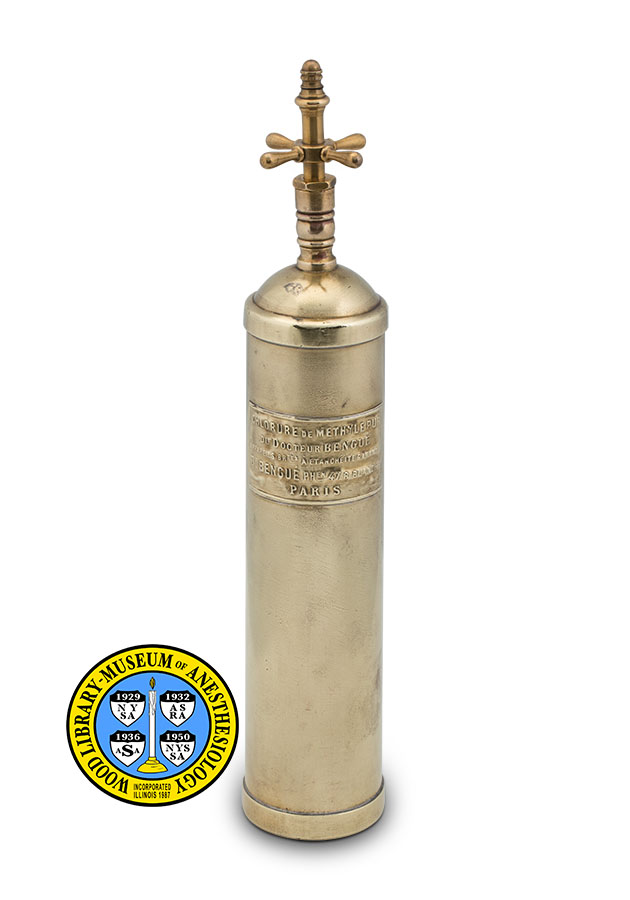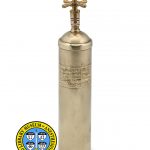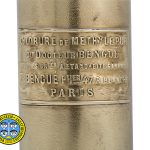Bengué Methyl Chloride
In 1892, Parisian pharmacist Jules Bengué, M.D., launched an international advertising campaign for his brand of liquid ethyl chloride, which was sold in tubes equipped with his patented spray nozzle. Ethyl chloride was first proposed as a general anesthetic in the 1840s. It was also discovered that, when sprayed onto the skin, its rapid evaporation resulted in cooling of the skin and a reduced nerve response to an incision. However, this speedy evaporation made it difficult to use.
Bengué's convenient packaging opened an era of great popularity for that agent as both a skin refrigerant and general anesthetic. The 1890s also saw the emergence of methyl chloride, both for general and local anesthesia, usually together with ethyl chloride. Also called chloromethane, methyl chloride is a toxic and flammable gas. It occurs naturally and is also manufactured, both as a gas and as a liquid, for industrial uses.
Both ethyl chloride and methyl chloride vaporize so quickly that the surrounding temperature drops, and contact with the skin can even cause frostbite. Each of these agents can also cause other serious health problems, and they are no longer used for anesthesia. Bengué's products included ethyl chloride, methyl chloride, combinations of the two, liniments and other analgesic preparations. The company's mixtures of ethyl and methyl chlorides were sold under several brand names, including Anestile, Choryl, and Narcotile. In the United States, Bengué's products were given an anglicized spelling that is still in use: Bengay.
Catalog Record: Bengué Methyl Chloride Methyl chloride
Access Key: apnx
Accession No.: 2014-06-07-1
Title: Chlorure de methyle pur.
Corporate Author: Bengue & Company.
Title variation: Alt Title
Title: Bengué methyl chloride dispenser.
Publisher: Paris : Bengue & Company, [between ca. 1909 and ca. 1930].
Physical Description: 1 methyl chloride dispenser : brass, metal ; 27 x 5 cm.
Subject: Anesthetics, Inhalation.
Subject: Anesthetics, Local.
Subject: Cryoanesthesia.
Subject: Drug Packaging.
Subject: Methyl Chloride.
Web Link: https://www.woodlibrarymuseum.org/museum/item/1046/bengué-methyl-chloride
Note Type: General
Notes: Title taken from the object. This object is a different example of the product than that described by Dr. Bause in 2002.
The first year in the date range is based on the earliest year in which the company is known by the cataloger to have been located on Rue Blanche (the address stated on the object.) The actual date of manufacture may have been somewhat earlier. The second year is based on the fact that anesthetic products containing methyl chloride were discredited in the late 1920s. The actual date on which production ceased may have been later.
The dispenser has been emptied of any liquid.
Note Type: Citation
Notes: Bause GS. “Bengue methyl chloride canister.” Anesthesiology. January, 2002;110(1):154.
Note Type: Citation
Notes: Bengué J, inventor. Receptacle for ethyl chloride. US patent 523,159. July 7, 1894.
Note Type: Citation
Notes: Bengué Company File. Archives. Located at: Wood Library Museum of Anesthesiology, Schaumburg, Illinois.
Note Type: Citation
Notes: Dandois L. Étude sur l’Anesthésie locale. In: Revue Médicale. Louvain: Charles Peeters, 1892:196. (Google Books, accessed February 14, 2017.)
Note Type: Citation
Notes: Haller A. Les Industries Chimiques et Pharmaceutiques, Tome I. Paris: Gauthier-Villars, 1903. [Google Books, accessed February 16, 2017]
Note Type: Citation
Notes: Her Majesty’s Stationery Office. Patents and Inventions, Abridgements of Specifications, Class 125, Stoppering and Bottling, Period A.D. 1889-92. London: Darling & Son; 1898. [Google Books, accessed February 14, 2017]
Note Type: Citation
Notes: Lefebvre T, Raynal C. Le lance parfum. Un matériel médical devenu accessoire de carnaval. Revue d’Histoire de la Pharmacie. 2008;95(367):63-79. Google Books website: http://www.persee.fr/doc/pharm_0035-2349_2008_num_95_357_6441. Accessed February 14, 2017.
Note Type: Citation
Notes: National Oceanographic and Atmospheric Administration website. Ethyl chloride. https://cameochemicals.noaa.gov/chemical/674. Accessed February 17, 2017.
Note Type: Citation
Notes: National Oceanographic and Atmospheric Administration website. Methyl chloride. https://cameochemicals.noaa.gov/chemical/1094. Accessed February 17, 2017.
Note Type: Citation
Notes: Richardson BW. Asclepiad. January, 1885;2(5):361-363. Hathi Trust website. https://babel.hathitrust.org/cgi/pt?id=mdp.39015026452808;view=1up;seq=9. Accessed February 14, 2017.
Note Type: Citation
Notes: Zimmer M. History of anaesthesia: early forms of local anaesthesia. European J Anaesthesiology. January, 2014;31(1):1-12.
Note Type: Physical Description
Notes: One methyl chloride dispenser; Consists of a canister with a removable head; The canister comprises a cylinder with a domed cap that meets a neck which is approximately 3 centimeters tall; The base of the cylinder is convex; On one side, the cylinder is embossed with a rectangular cartouche that surrounds the following, embossed, text: “: CHLORORURE DE METHYLE PUR [new line] DU DOCTEUR BENGUÉ [new line] APPAREILS BRTÉS À ÈTANCHEITE GARA[illegible] [new line] DR. BENGUÉ PHEN 47 R. BLANCHE, PARIS”; When the head is removed, the canister stands 22.5 centimeters tall from base to lip; The head alone is 7 centimeters tall, and screws into the neck of the canister; At the apex of the head there is a small aperture; The head is controlled by a capstan with four bars or handles; The capstan turns to the left to open, and to the right to close the aperture.
Note Type: Reproduction
Notes: Photographed by Mr. Steve Donisch, November 15, 2016.
Note Type: Historical
Notes: Parisian pharmacist Jules Bengué, M.D. (born 1863), received his medical degree from the University of Paris in 1891. The following year, he patented a spray nozzle that made it possible to apply rapidly-evaporating liquids conveniently and without waste. That same year he launched an international advertising campaign for his brand of ethyl chloride, sold in glass tubes equipped with his nozzle. Two years later, he patented a metal cylinder with spray attachment. This was followed by numerous other patents in several countries over the next three decades, and in 1935 he brought a patent infringement suit against an American competitor.
The company is known to have done business at 34 Rue La Bruyère, Paris from 1892 to 1903, at least. By 1909, and until 1922 at least, the company was located at 47 Rue Blanche, Paris. An undated package of Bengué ethyl chloride gives the address as “Dr. Bengué & Fils [i.e. Bengué and Son], 16 Rue Ballu, Paris” (Lefebvre p. 57.)
Ethyl chloride was first proposed as an inhalation anesthetic in the 1840s, but the speed of its evaporation made it difficult to use. The arrival of convenient packaging in the 1890s opened an era of great popularity for that agent as a short-acting local anesthetic. Dentists soon rediscovered that if a sufficient quantity was inhaled it could cause general anesthesia, and through the 1920s it was also used as an inhalation agent.
The 1890s also saw the emergence of methyl chloride both as an inhalation agent for general anesthesia, and as a local, topical anesthetic. It was primarily used in combination with ethyl chloride. The inhalation agent, Somnoform, contained ethyl and methyl chlorides.
Also called chloromethane, methyl chloride is a toxic and flammable gas. It occurs naturally and is also manufactured, both as a gas and as a liquid, for industrial uses. Both ethyl chloride and methyl chloride evaporate so quickly that the surrounding temperature drops, and contact with the skin can even cause frostbite. Each can also cause other serious health problems, and they are no longer used for anesthesia.
Bengué’s products included ethyl chloride, methyl chloride, mixtures of the two and other analgesic preparations, including throat lozenges and a topical cream called Bengué Baume Analgesique. Bengué’s combinations of ethyl and methyl chlorides were sold under several brand names, including Anestile, Choryl, and Narcotile. In the United States, Bengué’s products were given an anglicized spelling that is still in use: Bengay.
Note Type: Exhibition
Notes: Selected for the WLM website.



